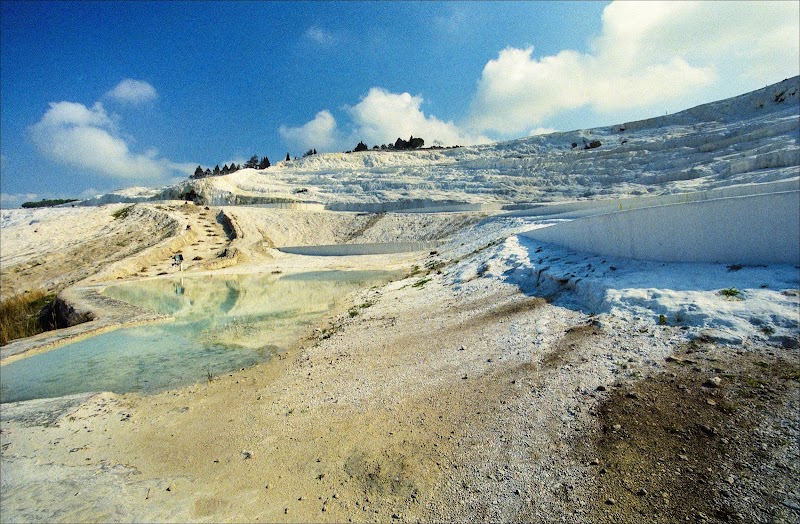Soaking in Serenity: Exploring Pamukkale’s Thermal Pools with Panoramic Views
Experience the unique blend of adventure and relaxation in Pamukkale’s thermal pools, where mineral-rich waters cascade down shining white terraces. With panoramic views over the Denizli plains and ancient ruins nearby, this natural spa invites travelers to soak while exploring one of Turkey’s most remarkable landscapes.
Wear Grip-Ready Footwear
Paths around the thermal pools can be slippery and uneven; choose shoes with solid traction to ensure safe footing.
Visit During Early Morning or Late Afternoon
Avoid crowds and intense sun by planning your visit before 10 AM or after 4 PM to enjoy a quieter, cooler experience.
Stay Hydrated and Use Sun Protection
The dry climate and reflective terraces increase dehydration risk, so bring water and wear sunscreen and a hat.
Respect the Pool Rules: Bare Feet Only
Shoes aren’t allowed in the pools to protect the fragile travertine; embrace walking barefoot as part of the experience.
Soaking in Serenity: Exploring Pamukkale’s Thermal Pools with Panoramic Views
Pamukkale, located in Denizli Province, Turkey, offers an unparalleled experience combining natural wonder and soothing relaxation. The travertine terraces, sculpted by mineral-rich thermal water over millennia, invite adventurers to sink their feet into pools that glisten like liquid marble under the Anatolian sun. These terraces are not just scenic; they actively challenge the visitor to respect the delicate balance between nature and tourism.
Arriving at Pamukkale, the first sensation is the warm caress of thermal waters urging you to pause and immerse yourself. Each pool, tiered along the limestone slopes, reveals a unique crystal-clear temperature and texture. The topmost pools present expansive views that stretch over the Denizli plain—a vast landscape that rivals the pools in grandeur. Here, the earth seems to breathe beneath your feet, alive with stories written in calcium and time.
The site requires walking on carefully maintained stone paths that often shimmer with wet surfaces, so sturdy footwear with grip is crucial. The main walking route spans about 2 kilometers with gentle elevation but uneven terrain, reminding visitors to balance thrill with caution. Early morning or late afternoon visits avoid crowds and harsh midday heat, enhancing the sense of calm that the site naturally radiates.
Water constantly flows in a deliberate rhythm down each terrace, as if nature itself pushes you forward, inviting the next step or soak. The water has reputed healing properties, rich in calcium and other minerals, perfect after a day spent trekking nearby or exploring the ancient city of Hierapolis adjacent to Pamukkale.
Local regulations prohibit shoes in the pools to protect the fragile travertine crust; walking barefoot becomes a grounding experience that connects body and earth. Respecting this helps preserve the formation’s fragile beauty.
For those planning to extend their adventure, Denizli city offers practical accommodations and easy transport links, making Pamukkale an accessible highlight of any Turkey itinerary. Hydration and sun protection remain key—thermal areas reflect sunlight intensely, and the dry climate can dehydrate faster than expected.
Relaxing in Pamukkale’s travertine pools is more than a soak; it’s an encounter with a fiercely ancient landscape that demands quiet respect and rewards those who prepare well with lasting memories and rejuvenation.
Nearby Trips
All Adventures
Boat Charters
Water Activities
Adventures near Denizli
Discover the unique and memorable adventures that make Denizli special.
Frequently Asked Questions
Is swimming allowed in the Pamukkale thermal pools?
Swimming is not allowed in most of the natural terraces to protect the delicate travertine layers. However, nearby antique thermal pools like those in Hierapolis offer authorized bathing areas.
How do I get to Pamukkale from Denizli city?
Pamukkale is approximately 20 km from Denizli. Regular minibuses and taxis provide frequent transport, and many tour companies offer guided trips as well.
What is the best time of day to visit Pamukkale for photographs?
Early morning light or late afternoon golden hour offer the best conditions, with soft shadows enhancing the texture of the terraces and fewer people around.
Are there restrictions visitors should know about at the pools?
Visitors must remove footwear before stepping on the terraces to prevent damage. Eating, drinking, and touching the pools beyond bathing areas are also restricted to preserve the site.
Can I visit Pamukkale year-round?
Yes, Pamukkale is open year-round, but summer heat and winter cold can affect your experience. Spring and fall offer ideal weather for comfort and exploration.
What other attractions are near Pamukkale?
The ancient city of Hierapolis lies adjacent to the terraces, featuring ruins like the theater and necropolis. Nearby Kaklik Cave and Denizli city add cultural and natural variety.
Recommended Gear
Waterproof hiking sandals or slip-resistant shoes
Provides grip on wet terraces and easy removal before entering pools.
Wide-brimmed hat and sunscreen
Protects against intense sun reflected by white travertine surfaces.
Reusable water bottle
Staying hydrated is crucial in the dry, evaporative climate.
Light jacket or windbreaker
Useful for cooler mornings, evenings, and unexpected weather.
Local Insights
Hidden Gems
- "Cleopatra Antique Pool in Hierapolis nearby offers a rare chance to swim among submerged Roman columns."
- "Higher terraces on the southern edge reveal small, less visited thermal pools with private views."
Wildlife
- "Watch for native bird species such as wagtails and hoopoes that feed along the warm pools."
- "Occasional sightings of tortoises basking near the rocks add quiet life to the landscape."
History
"Pamukkale has been prized since Roman times as a healing spa, forming part of the ancient city Hierapolis, a UNESCO World Heritage Site rich in Greco-Roman ruins."

